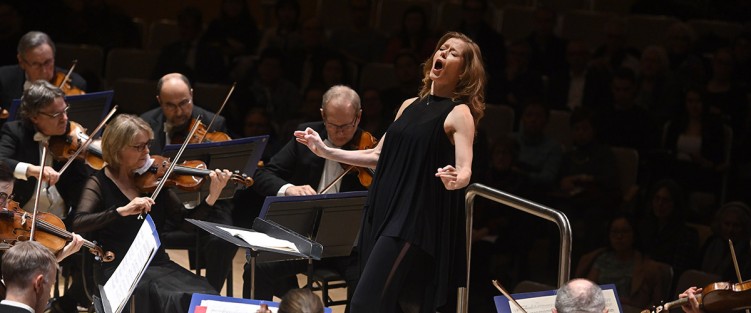This article appears in The WholeNote as part of our collaboration in the Emerging Arts Critics program.

The evening began with principal flutist Kelly Zimba performing Debussy’s Syrinx for solo flute. Yet we were in for a surprise from the very first notes: the lights were dimmed to near darkness with a single spotlight on Zimba, standing in the first balcony in the audience. Her sound soared into the hall, offering a tone of such supreme delicacy and elegance – reminding one of a feather gliding through the air.
As the final notes of the Debussy lingered, the lights brightened onstage to reveal Barbara Hannigan already at the podium. Luonnotar for Soprano and Orchestra, Op. 70 by Sibelius began without applause – a very well-thought out decision so that the spell cast by the Debussy was not broken. This piece was a milestone for Sibelius, as it marked the beginning of his later compositional style, and is seldom performed due to the immense technical difficulties it poses for the singer. One would never know that there were any in Hannigan’s performance: she sang with the utmost ease. The effect was mesmerizing; the audience sat unusually silent, as though in a trance. With the supportive leadership of concertmaster Jonathan Crow, the orchestra lay down the perfect velvet backdrop for Hannigan’s crystalline voice.
Following the Sibelius, the audience was transported from a land of mythical fantasy to that of courtly majesty with Haydn's Symphony No. 86 in D Major. Some moments lacked unity in the orchestra (perhaps due to Hannigan’s circular and maybe slightly ambiguous beats), but what was never missing was the spirit of each phrase. This work is known for its striking contrasts in dynamics and textures, which were exemplified in the orchestra’s playing from the first few minutes. The second movement is full of the unexpected, with many twists and turns written into the music, and the TSO’s playing heightened this effect of the unpredictable. The first two movements felt a bit rough around the edges, but by the third and fourth movements the entire orchestra seemed entirely engaged in the vibrant music-making.
Berg’s Symphonic Pieces from the Opera “Lulu,” a suite of five movements composed in 1934, brought us to a world of madness and mania. Lulu was the last work that Berg wrote before he died and, in fact, he passed away before completing it. It uses the twelve-tone system combined with more traditional music forms to not only tell the story of the main character Lulu’s life and death, but also as a way of commenting on the dishonesty of bourgeois men. This suite features music from some of the most emotionally-charged, dramatic moments in the opera.
For the Toronto Symphony’s performance, the suite provided many instruments in the orchestra with an opportunity to shine in the spotlight, including some very fine playing by oboe, clarinet, and saxophone. Principal leaders of the violin, viola, and cello sections also played expressive solos that emerged above the orchestral texture. The “Lied der Lulu” movement showcased Hannigan singing as she conducted. The downside of this was that she occasionally sang with her back to the audience – yet this also had a certain effect as it added to the otherworldly aura of the music-making, Hannigan’s transcendent voice arising out of seemingly nowhere.
The final movement of the Berg was the most thrilling of all. The music features an ominous, dense sound that creeps towards a climax. Hannigan had us holding our breath as she pulled the orchestra towards this impending doom. And what a climax it was when, after a brief silence, the entire orchestra launched into this tidal wave at full force while Hannigan shook her baton wildly in the air.
It comes as no shock to reveal that the Berg and the final piece on the program, a suite arranged by Barbara Hannigan herself from Gershwin’s Crazy Girl, are featured on Hannigan’s Grammy Award-winning CD, Crazy Girl Crazy. This was no doubt the grand finale and highlight of the concert as we entered yet another musical world – that of 1930s glamour and sparkling dances. Hannigan was in her element as her voice, with the aid of a discreetly-added microphone, filled the hall and she transformed the TSO into a lively, swinging big band. There was impromptu applause for the orchestral members who briefly put down their instruments to sing a very charming (and in tune!) verse of “Embraceable You,” and I couldn’t withhold the smile that spread across my face as Hannigan embodied the theatricality of Gershwin’s “I’ve Got Rhythm.” The audience was on their feet roaring with applause before the final note had even finished sounding in the hall; it was a perfect way to end a transcendent musical experience.
Hannigan was the music during this entire concert – capturing the spirit and essence of every single piece and composer on the program. Many conductors coax refined playing out of orchestras that is beautiful, cohesive, and sensitive to the composer’s indications. Barbara Hannigan offered something beyond this, though: she immersed herself fully in the music and as a result enthralled the orchestra and the audience in an engaged, magnetizing experience.
The Toronto Symphony Orchestra presented “Barbara Hannigan Sings & Conducts” on February 13 and 14, at Roy Thomson Hall, Toronto.
Leslie Ashworth is a violinist and composer studying her Bachelor of Music Performance degree as a recipient of the Tim & Frances Price Scholarship at the Glenn Gould School, Royal Conservatory of Music. Leslie is passionate about reading and writing and is a participant in the 2018/19 Emerging Arts Critic program.

